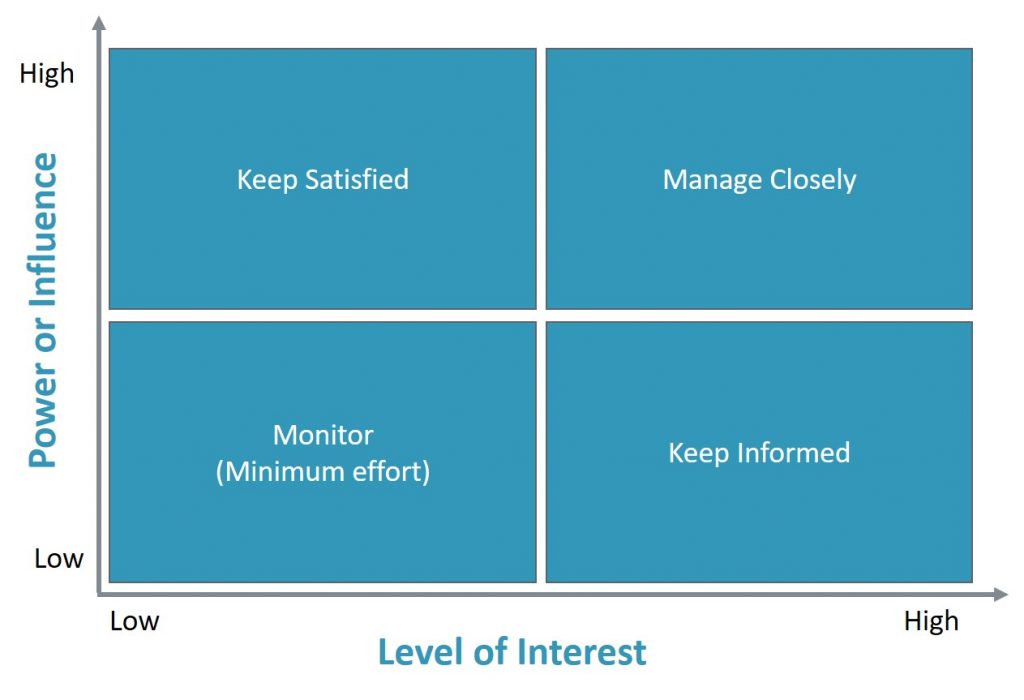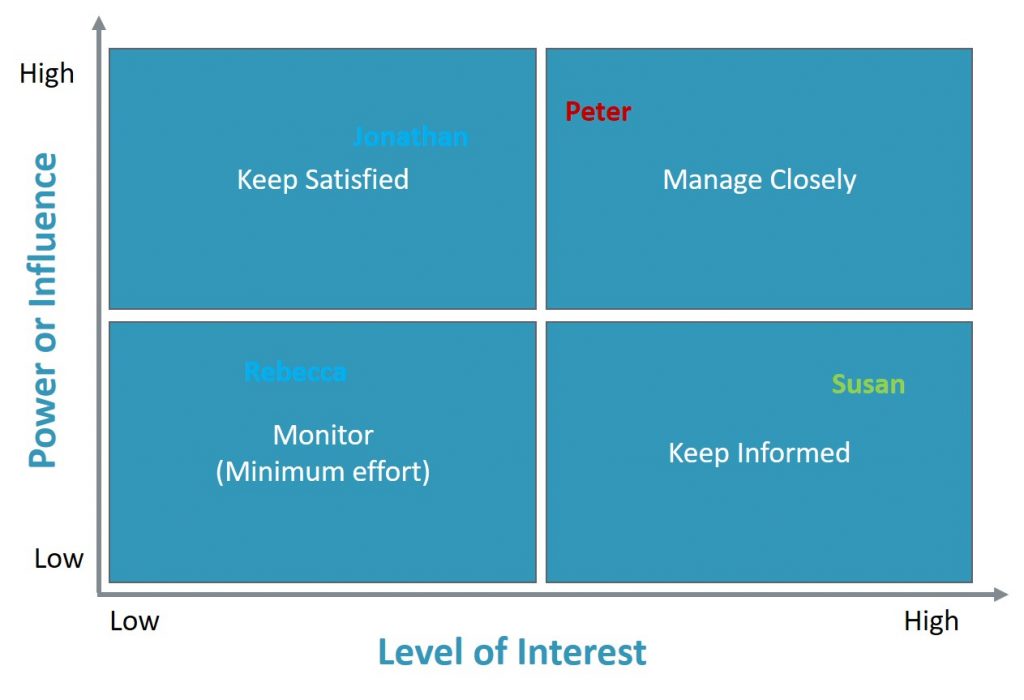Stakeholder Management is one of the core skills that every Project Manager or Change Manager needs to master. However, in my experience it is something that is often done badly or even ignored completely.
In this blog, I will present the Power Interest Matrix as one of the tools I use to help manage project stakeholders.
Stakeholder Management
Firstly, let’s define what we mean by a stakeholder, particularly in relation to projects and change.
Very simply, a stakeholder is anyone who is either interested in the project or is likely to be affected by the project (this could be whilst the project is ongoing and / or after it has completed). In fact, anyone with a stake in the project is by definition a stakeholder.
Before we can begin to manage our stakeholders we need to identify who they are. Stakeholders can either be individuals (e.g. the project sponsor) or groups of people (e.g. our customers, the general public, or staff).
A lot of stakeholder management is about good communication, but we can only communicate with individuals not organisations. Therefore if our stakeholder groups consist of organisations then we need to think about which person(s) we are going to communicate with.
Identify the stakeholders
The first step in our Stakeholder Analysis is to brainstorm who our stakeholders are. This is best done by a small group of the core project team led by the Project Manager. Think of all the people who are affected by the project, who have influence or power over it, or have an interest in its successful or unsuccessful conclusion.
Once we’ve identified our stakeholders, we can then turn to how we will manage them. This is where the Power Interest Matrix comes in. The tool maps the power and influence that stakeholders have on a project or its outcomes. It helps project managers determine which stakeholders they need to focus on and the actions they should take.
Using the Power Interest Matrix
Categorise your list of stakeholders depending on their power and interest in the project. Some of them may have the power either to block or advance your project. Some may be very interested in what you are doing, others may not be so bothered.
Depending on the culture of the organisation, this can often be an uncomfortable process for team members. High levels of trust are needed amongst team members. This is definitely and area where an external facilitator or consultant can add a lot of value. They can keep the analysis objective and are outside the internal politics of the organisation.
When you plot your stakeholders on a power/interest grid, you can determine who has high or low power to affect your project, and who has high or low interest.
People with high power need to be kept satisfied, while people with high interest need to be kept informed. When a stakeholder has both, make sure you manage his or her expectations very closely.

The diagram above shows the different approach you should have for the segregated stakeholders.
- High power – High interest: these stakeholders are likely to be decision makers and have the biggest impact on the project success. You need to keep these stakeholders close, to manage their expectations.
- High power – Low Interest: these stakeholders need to be kept in the loop with what is happening on the project. Even though they may not be interested in the outcome, they yield power. These type of stakeholders should be dealt with cautiously because they could use their power in a negative way if they become unsatisfied.
- Low power – High interest: keep these people adequately informed, and talk to them to ensure that no major issues are arising. These people can often be very helpful with the detail of your project.
- Low power – low interest: monitor these people, but do not spend time and energy with excessive communication.
One tip I have to better visualise stakeholders potential impact on the project, is to colour code them. Red for negative, green for positive and blue for neutral. This can then be used to help develop management and communication strategies for each of your stakeholders.

To simplify stakeholder analysis I have made my own Excel template that can be used to analyse stakeholders and categorise them into the 4 quadrants of the Power Interest Matrix.
It also combines the power and interest classification with two other categories to assess their reaction to the project and the level of support needed.
RACI Matrix
Another useful tool for managing project stakeholders is the RACI Matrix (Responsible, Accountable, Consulted, Informed).
I’ve written about this before in my article “Are you Responsible or Accountable? (Interestingly this is the most read article on my blog, achieving over 5 times more hits than my other top performing articles in the same time period!) Check it out here:
If you’ve found this article useful and would like a copy of my stakeholder management template then please either click the button below or use the Contact Us form to request further information.
As stated at the beginning of the article Stakeholder Management is one of the core skills of any project or change manager. It comes in at number 2 of my 5 fundamentals for a successful project. You can read about the others here:






19 responses
hello, lovely article and very helpful. I am currently working on a change for a law firm to exploit big data in their operations and I would love a copy please. This would be very useful in implementation while considering the various stakeholders likely to resist. thank you
Hi Obie,
Thank you for your feedback. Please use the ‘Get in touch’ option at the top of the page to leave a message with your email address. I’ll send you the template as an email attachment.
Best regards
Paul
This article was very helpful. could you please send me your template.
Hi, this is useful – could you please send template to my email – tasnima98@gmail.com
thanks alot of information
This is an awesome piece and we’ll explained, please send me a copy of your template rehiawaguan@gmail.com
Thanks
Hi, this is very useful – could you please send template to my email –
zlypatience@dingtalk.com
Thanks for your feedback, I’ve sent the template to the email provided.
he topic is very useful.
kindly send me the template to email: tuwera.almazrooe@gmail.com
Hello and thank you for putting this very useful article together! Would it be possible to send the template to my email please? constantin.adrian.p@gmail.com
Thank you very much!
hi there, thanks for this topic, it really helped me in my studies, could you send the template to the email provided.
This is very helpful, could you send me the template?
This is very useful. I am a student doing project management. Could you please end me the template to my email kanchanabk@yahoo.com
Thanks
This is very informative. I am doing project management. Could you please end me the template
Thanks
Thanks for your interest, I’ve sent you an email with the template
Hi Paul this was a very enlightening article and I would love to have further discussions with you. Please send me a copy of your template
Looking forward to hearing from you!
hi there, great work very informative and helpful for my project. Can you please send me the copy of your template on ayazsaleemqureshi@gmail.com ?
Great Article, very helpful. Please could you send over the templates as described regarding stakeholder mapping/matrix/management?